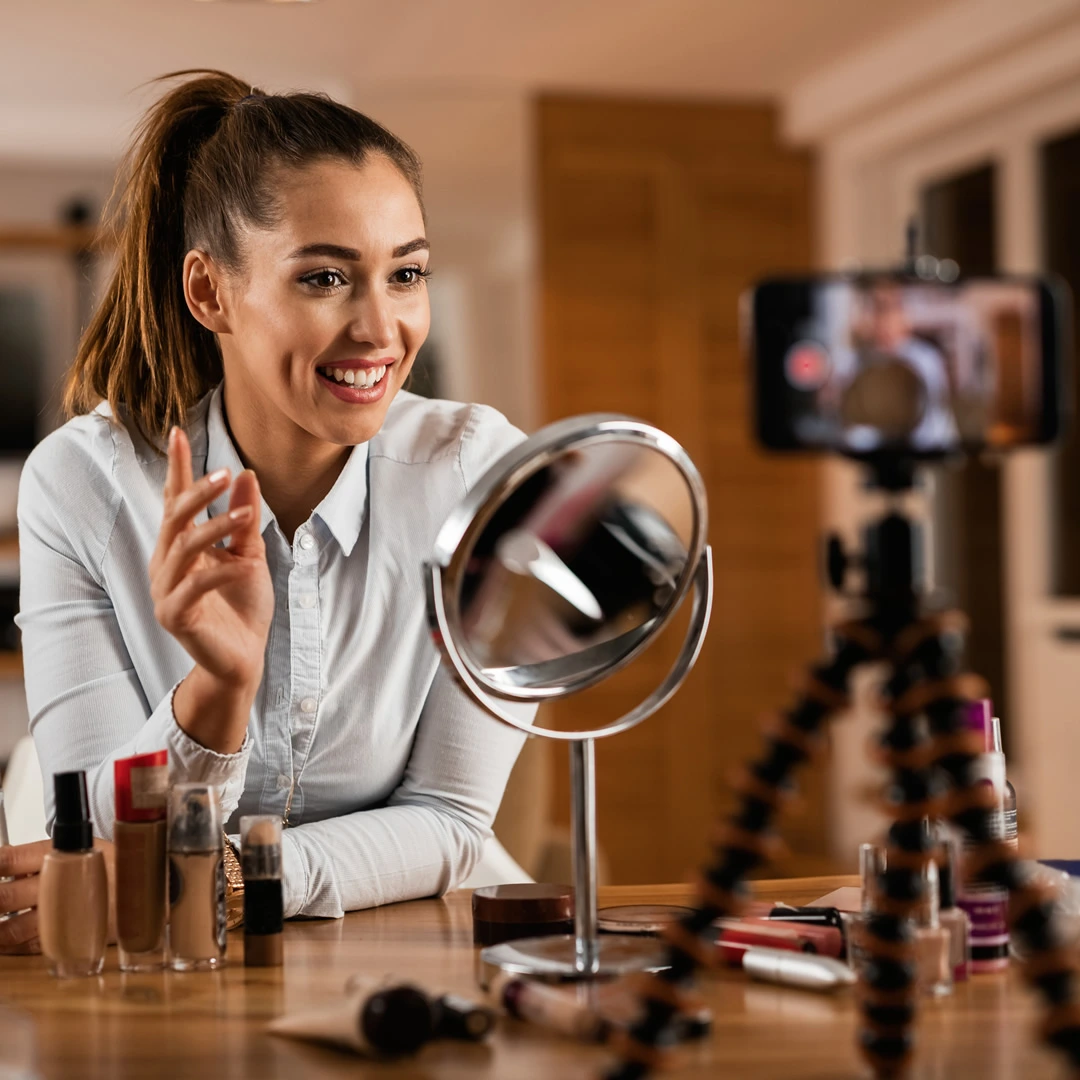

Whether you’re just starting out and are looking for social media tips for beginners or for general social media marketing advice, we’ve listed some great articles to help you navigate social media marketing and boost engagement for yourself, business or brand.
We’re constantly adding Social Media Marketing Ideas, News & Tips – check out the articles below. Sign up to our Social Media Marketing Newsletter to get these delivered straight to your inbox.

Are you struggling to make Reels? Does your video content strategy need to change?
In this article, we’ll explore four easy ways to make better Instagram Reels.
Instagram Reels have become an important tool for businesses and creators to reach new audiences. However, many people struggle to create engaging Reel content. Before diving into the...

Do you need a better Instagram marketing plan? Wondering how to use Reels, Carousels, and photo posts to convert more followers?
In this article, you'll learn how to create a sustainable Instagram strategy.
With over 2 billion monthly active users and a constantly evolving algorithm, standing out and achieving long-term success on Instagram can be...

Want to make your marketing more relatable? Wondering how humour could help?
In this article, we’ll explore how to embrace humour in your writing.
Humour can be a powerful marketing tool that can increase brand awareness an customer loyalty, but many marketers shy away from using it. They worry about offending people or think they're...

Are you struggling to make social media work for you? Wondering how your marketing needs to change? In this article, we’ll explore how marketers can embrace changing times. Marketers face numerous challenges regarding their social media presence today. The rules of the game have changed significantly in recent years, and marketing strategies that..
READ MORE
Need help developing a winning Instagram Reels strategy? Wondering how to create Reels that both entertain and sell?
In this article, we’ll explore a short-form video strategy that helps you connect, engage, and sell across Instagram and beyond.
Instagram has become a powerful platform for businesses and creators to connect with their audience. But..

Struggling to sell your products or services on Instagram? Want to know how to effectively create content that leads to sales?
In this article, you'll learn a proven organic framework for selling more on Instagram without relying on paid ads.
In today's digital age, businesses are always looking for effective ways to increase their sales and reach their target....

4 Easy Ways To Make Better Instagram Reels
Are you struggling to make Reels? Does your video content strategy need to change?
In this article, we’ll explore four easy ways to make better Instagram Reels.
Why Instagram Reels Matter
Instagram Reels have become an important tool for businesses and creators to reach new audiences. However, many people struggle to create engaging Reel content.
Before diving into the strategies, it's important to understand why Reels are so valuable. Reels offer a unique opportunity to reach people who don't follow you. While other Instagram features like hashtags have become less effective for discovery, Reels are still “reach heavy,” according to social strategist Shannon. This means your Reels have a good chance of being shown to new potential followers.
Reels also help build trust quickly. In a world where we're constantly scrolling through content, video allows you to make a stronger connection with viewers. If you want to grow your following and stay top of mind with your audience, Reels are a great way to do it. Reels are particularly effective for getting in front of new audiences, which is crucial for many businesses.
Another advantage of Reels is that they don't require a background in video production. Anyone can create effective Reels with just a smartphone and some creativity. This accessibility makes Reels a powerful tool for businesses of all sizes.
1: How To Create Instagram Reels Content That Makes People Feel Heard
The first pillar of Shannon's Reels strategy is to create content that makes your audience feel heard and understood. This type of content helps people feel validated and creates a human connection. When someone feels heard when they see your content, it can have a powerful impact, even if the Reel doesn't go viral.
To create “feeling heard” content, consider your audience's challenges, frustrations, or experiences. For example, a nutritionist might create a Reel saying, “I don't know who needs to hear this, but worrying about the ice cream is more unhealthy than just having a bowl of ice cream,” with footage of swirled ice cream in a cone. This simple message acknowledges many people's everyday struggles and offers a comforting perspective.
The key is to put the main message as text on the screen all at once, rather than revealing it slowly. This approach caters to today's fast-paced content consumption habits.
Other approaches to creating “feeling heard” content include using phrases like “I don't mean to interrupt your scrolling, but…,” “This is your sign to…,” or “I wish more people knew…” These introductions signal to viewers that you're about to share something relatable or important. You can also offer reminders or pep talks related to your niche. For instance, if you're a social media marketer, you might remind your audience that taking a break from posting is okay if they're feeling overwhelmed.
The key to this type of content is understanding your audience deeply. What are their daily struggles? What keeps them up at night? By addressing these issues, you create content that resonates on a personal level, fostering a stronger connection with your viewers.
2: How To Create Instagram Reels That Are Helpful
The second pillar of Shannon's strategy is to create helpful content. This is where you can share tips, tricks, and educational information. But be sure to keep it simple and easy to digest. “So what I tend to do for my clients, for the helpful, if it is going to be a list of like five, 10 things again, be so specific and keep it so simple and doable where they don't have to go out and buy the thing. They don't have to go out and build the thing,” Shannon says.
When creating helpful content, focus on providing value your audience can immediately act on. This could be a quick tip related to your industry, a short how-to guide, or a simple solution to a common problem. For example, if you're a coffee shop owner, you might share a quick tip on how to froth milk at home for the perfect latte.
You can also use the phrase “I found” to introduce helpful content. For instance, “I found the best podcast mic for beginners as a newbie podcaster” or “Here's how I use Meta Business Suite to schedule my content as a social media manager.” This approach feels more personal and authentic than simply telling people what they should do. It also establishes your expertise in a friendly, approachable way.
Another effective format for helpful content is the “POV” (Point of View) Reel. For example, one of Shannon's clients created a POV Reel for parents dealing with toddler tantrums. The Reel said, “POV: You're tired of your toddler having tantrums at the grocery store, and then you find my account.” The video shows the creator holding her child's hand. In the caption, the creator provided helpful tips for managing tantrums.
This format allows you to present a problem and offer a solution in a relatable way. You want to demonstrate the customer's desired feeling or end state here. For example: “POV: You're a coffee lover in Raleigh, NC, and you find this brand new coffee shop that serves birthday cake lattes.” The Reel could show a person enjoying the latte.
Remember, your helpful content doesn't always need to be complex or revolutionary. Sometimes, the simplest tips can be the most valuable to your audience. The key is to make your content actionable and easy to implement.
3: How To Create Instagram Reels Using Humour
The third pillar of Shannon's strategy is humour. This might seem intimidating, especially if you don't consider yourself naturally funny. But it doesn't have to be side-splitting humour - even a small chuckle can be effective.
To create humorous content, create a bank of ideas by thinking of relatable situations in your industry or niche. For example, you could create humor for marketers by “poking fun at Meta Business Suite and how complicated it is” or “thinking this Reel's gonna go viral and it gets 200 views and one spam account.” These situations are relatable to anyone who works in social media marketing, making them perfect for humorous content.
One way to incorporate humour into your Reels is by using trending audio clips. These are often snippets from movies, TV shows, or popular songs that people lip-sync to while adding their own visual content. You don't even have to lip-sync if you're uncomfortable doing so— you can simply use the audio as a background while showing relevant visuals.
Note: Choose trending audio that is not overly saturated (less than 5K uses). If you have a business account on Instagram, you can go to your professional dashboard and scroll to trending audio to look for the most popular sounds.
If you're uncomfortable being on camera or lip-syncing, use tools like CapCut to create simple, funny video edits. CapCut allows you to use stock footage or GIFs and add your own captions to create humorous content. For example, you could use a funny GIF of someone looking confused and add text relating it to a common challenge in your industry. For inspiration, look at TikTok, Shannon says.
Pro Tip: Open your Instagram app and go to the Reels camera. Select your video, and then visit the Clip hub to find funny GIFs.
Instagram's Stories camera is also a valuable tool for creating Reel content. It automatically films in the correct dimensions for Reels (9:16 aspect ratio), making it easier to create content that fits the format.
Remember, the goal of using humor in your Reels is to be relatable and bring a smile to your audience's face. You don't need to be a comedian to add a touch of humor to your content. Often, simply acknowledging the everyday challenges or quirks of your industry can be enough to create a connection with your viewers.
4: How To Create Instagram Reels That Share Happenings
The final pillar of Shannon's strategy is to share “happenings”—behind-the-scenes content, stories, and updates from your life or business. This type of content helps your audience feel connected to you and your brand on a more personal level.
“Happenings” content is what makes social media truly powerful. It lets you share your journey, challenges, and triumphs with your audience. This could include sharing your founder's story, giving a behind-the-scenes look at your work process, showcasing your team or workspace, or sharing updates about new products or services.
For example, if you run a coffee shop, you might create Reels showing how you open the shop in the morning, introducing your baristas, or demonstrating how you make your most popular drinks. Shannon suggests ideas like “Pack a $200 order with me” for eCommerce businesses, showing the process of fulfilling an order.
While this type of content might not always go viral, it serves an important purpose. It helps build a stronger connection with your existing audience, giving them a reason to keep following you and helping them feel more invested in your brand. This content is particularly effective for local businesses, as Instagram often pushes content to Instagram users who are geographically close to you.
When creating “happenings” content, don't be afraid to get personal. Share your journey, your challenges, and your victories. This could be as simple as sharing a quick update about a conference you attended or as in-depth as telling your full founder's story.
Create a longer, more detailed “happenings” Reel to pin to your profile grid. Your pinned content (you can pin up to three pieces of content to your IG grid) could serve as an introduction to new visitors, much like an “About” page on a website. This serves as a home base for people considering your product or business. Think of your pinned Reels as a mini-website, with one Reel introducing you or your brand, another showcasing your services, and perhaps a third highlighting a key achievement or popular product.
Making Your Instagram Reels Stand Out: ‘The 3 S's’
To make your Reels more effective, Shannon recommends focusing on what she calls the “Three S's”:
Simple: Is your content easy to understand and digest quickly? In today's fast-paced social media environment, you need to get your message across quickly and clearly. Avoid complex explanations or ideas that require a lot of background knowledge. Also, study the text placement in Reels. Make sure it's centred in the middle, not cut off by icons. You want people to notice your text when it appears in your IG grid.
Shareable: Would someone want to share this with their friends? You want to create content that makes people want to be the “group chat hero” - the person who shares something so good that all their friends react positively. Think about what makes you want to share content with your own friends and try to recreate that feeling in your Reels.
Specific: Are you being clear about why people should care about your content? It's important to be specific, especially in your hooks (the opening of your Reel). Instead of a general “Instagram tip,” try something like “Instagram Tip to get out of 500-View Jail” or “Instagram Reel idea that helped me get 1K new followers.” By being specific, you're telling viewers exactly why they should care about your content.
When creating your Reels, always ask yourself these questions—think like your ideal follower. The more you can say “yes” to each of these, the more likely your Reel is to perform well.
Specificity is critical in today's crowded social media landscape. A few years ago, you could simply say “Instagram tip” and get attention, but now you need to be much more specific to stand out. Always consider why your audience should care about what you're sharing and make that clear from the start.
Overcoming Common Instagram Reel Challenges
If you're feeling intimidated by creating Reels, you're not alone. Many people struggle with various aspects of creating video content. Here are some common challenges and how to overcome them:
“I'm not comfortable on camera”: You don't always need to show your face in your Reels. You can use B-roll footage (supplemental or alternative video clips) instead. This could be as simple as filming your hands while you work, showing your product in use, or even using stock footage related to your message. You can then add text overlays to convey your main points.
“I'm not funny”: Remember, humour doesn't have to mean laugh-out-loud funny. Even a relatable situation that makes people smile can work. Focus on the everyday situations or frustrations that your audience experiences and present them in a light-hearted way. Often, simply acknowledging a common challenge can be enough to create a connection with your viewers.
“I don't have time to create complex videos”: Many successful Reels are very simple. A Reel can be as short as 5–6 seconds. It could be a single shot with on-screen text or even just you smiling at the camera with a text overlay sharing your message. Don't let the idea that you need to create elaborate productions hold you back from creating Reels.
“I don't know what to post about “: Use Shannon's four pillars (Heard, Helpful, Humor, Happenings) to brainstorm ideas. Keep a running list of potential topics. Pay attention to the questions your customers frequently ask, the challenges they face, or the aspects of your work that others find interesting. These can all be sources of content for your Reels.
Remember, the goal is to create content that resonates with your audience. It doesn't have to be perfect—authenticity often performs better than polished perfection. Experiment with different types of content and see what works best for your brand and target audience.

Creating A Sustainable Instagram Strategy In Five Easy Steps
Do you need a better Instagram marketing plan? Wondering how to use Reels, Carousels, and photo posts to convert more followers?
In this article, you'll learn how to create a sustainable Instagram strategy.
Why Marketers and Creators Struggle With Instagram Marketing
With over 2 billion monthly active users and a constantly evolving algorithm, standing out and achieving long-term success on Instagram can be challenging.
One of the most significant challenges faced by content creators and marketers on Instagram, regardless of their role or industry, is the struggle to have their content seen by their target audience.
Despite investing considerable effort and creating high-quality social media posts, many find that their content isn't reaching the same level of audience as it once did or that they believe it deserves. This lack of visibility leads to frustration and hinders their ability to engage with their intended audience effectively on Instagram.
With the constantly evolving social media marketing landscape, it's crucial to develop a sustainable Instagram strategy that allows you to effectively reach your target audience without burning out.
Social media strategist and Adobe Global Ambassador Lucas shares his expert insights on how content creators and business owners can maximize their exposure on Instagram.
Creating an Instagram Marketing Strategy: The ‘ACCEL’ Framework
Lucas provides a comprehensive roadmap for achieving long-term success on Instagram. His “ACCEL” framework comprises five key elements: Audience, Content, Consistency, Engagement, and Liftoff.
1: Audience - Identifying Your Ideal Follower
The first step in creating a winning Instagram marketing strategy is identifying your target audience. Just as marketers determine their ideal customer avatar, Lucas encourages users to find their ideal follower on Instagram. This involves diving into your niche, examining what other successful accounts are doing, and understanding who they are speaking to. By identifying the questions and needs of your ideal audience, you can create Instagram content that resonates with them, leading to increased engagement, shares, and conversions.
To find your ideal follower, look at the comments on posts by other Instagram accounts in your niche.
Identify the questions people are asking and the conversations they are having. This will give you valuable insights into what content will perform well and help you stand out in your niche.
2: Content - Choosing the Right Format for Your Message
With a clear understanding of your audience, the next step is determining the most effective way to communicate your message. Instagram offers diverse content formats, including Reels, Carousels, single images, and more. It is important to find the format that aligns with your strengths and your audience's preferences.
Due to their highly shareable nature, Reels are an excellent option for those seeking to maximize reach and discoverability. Instagram's CEO, Adam Mosseri, has stated that shares, or “sends,” are the top metric for achieving a wider reach. Instagram users tend to share video content more frequently than static posts, making Reels a powerful tool for growing your audience.
Carousels, on the other hand, excel at building trust and driving conversions. By taking your audience on a multi-slide journey, you can hook them with engaging visuals and compelling copy, ultimately leading them to a strong call to action on the final slide.
Instead of just doing a photo dump, consider using Carousels as a mini eBook or PDF guide to deliver value to your audience.
Carousels are the only content format on Instagram that will be shown to your audience twice, increasing the chances of them engaging with your post.
Note: Instagram is expanding the number of slides in Carousel posts from 10 to 15.
When creating Carousels, use graphic design tools like Adobe Express or Canva. These platforms offer templates specifically designed for social media Carousels, making creating visually appealing and informative Instagram posts easy. Be sure to include a strong hook on the first and second slides, as these are the most likely to be seen by your audience.
Single image posts, particularly infographics and checklists, are another effective way to share your message. You can easily make these using the graphic design tools mentioned above. The key is to identify your dominant content type—the format that you can create easily and at a high quality—and focus on creating the majority of your posts in that format.
3: Consistency - Developing A Sustainable Posting Schedule
Consistency is crucial for keeping your audience engaged and growing your Instagram presence. However, Lucas cautions against falling into the trap of “content sprints,” where you post daily for a short period and then burn out. Instead, he recommends finding a sustainable posting schedule that allows you to show up regularly without sacrificing quality or your well-being.
Aim for 4–5 weekly posts, with 3 out of 5 being your dominant content format. This allows for variety while maintaining a strong focus on your strengths. One post can be promotional, showcasing your products or services, while another can be a single image that gives your audience a behind-the-scenes look at your brand.
When generating content ideas, set aside time for brainstorming without self-criticism. Jot down all relevant ideas, even if you don't use them, and consider topics and questions your audience has shown interest in.
You can also use Instagram's built-in “Collections” feature to save posts for later reference and inspiration. Simply create specific folders within your saved posts, such as “inspiration” and “promotion,” to organize content ideas and examples of successful brand partnerships.
Then, you can refer to these saved posts to identify topics that resonated with the audience or worked well for other content creators. You can adapt successful ideas by adding your own unique perspective and voice to create a content strategy that will likely perform well for your audience.
Use a “phase content creation” approach to make content creation more manageable. Instead of trying to create a post from start to finish in one sitting, break the process down into phases: content ideation, writing, designing or filming, editing, and scheduling. You can create a week's worth of high-quality content in around two hours by dedicating focused time to each phase.
4: Engagement - Building Authentic Relationships
Engagement is the key to turning your social media marketing efforts into a social experience and getting your content seen by your target audience. Lucas emphasizes the importance of authentic engagement, likening it to attending a networking event and having genuine conversations with others in your niche.
One effective social media strategy is to leave thoughtful comments on posts by people who have previously engaged with your content. This helps foster a sense of community and increases the likelihood of them continuing to interact with your posts. Comments always get their own line in the notifications feed, making them a powerful way to get noticed by the post's creator and their audience.
Another approach is to reply to Instagram Stories, which can lead to organic conversations and opportunities to build relationships. When watching Stories, look for opportunities to start casual conversations, such as commenting on someone's pet or asking a question about their day. This can lead to back-and-forth direct message (DM) conversations, strengthening your connection with that person and increasing the chances of them seeing your content in their Instagram feed.
Lucas shares a one-hour engagement routine that helps maximize your impact without leading to burnout:
By consistently following this routine, you can build authentic relationships, increase your visibility, and drive more engagement to your content.
5: Liftoff - Leveraging Instagram's Features For Growth
The final component of the “ACCEL” framework involves utilizing the various features Instagram offers to grow your business and brand. Lucas highlights several key opportunities:
Instagram Live: Going live on Instagram is a powerful way to build trust, promote your offerings, and collaborate with others in your niche. Lucas has used Instagram Live to host talk shows with other creators, promote product launches, and conduct Q&A sessions. Live Instagram videos can be repurposed as main feed content, making them a versatile addition to your content mix.
Collaborations: Instagram's collaboration feature allows you to create joint posts with up to three other users, exposing your content to multiple audiences simultaneously. This can lead to increased reach and engagement for all collaborators involved. Lucas has seen great success with this feature, creating Carousel posts that alternate between his content and his collaborator's.
Link in Bio and Automation: To drive traffic and conversions, use a single, clear call to action in your bio link. Tools like ManyChat can also automate DM or comment responses, directing users to your latest offerings when they comment with a specific keyword.
Remember that building a thriving presence on Instagram takes time and effort. Focus on creating value for your audience, fostering genuine connections, and adapting to the ever-changing social media landscape.

Embracing Humour In Your Writing: The Funny Side of Business
Want to make your marketing more relatable? Wondering how humour could help?
In this article, we’ll explore how to embrace humour in your writing.
Why Use humour In Marketing?
Humour can be a powerful marketing tool that can increase brand awareness an customer loyalty, but many marketers shy away from using it. They worry about offending people or think they're not naturally funny.
However - Lianna, explains that using humour in marketing has several important benefits. First, it makes people feel good and activates the brain's fulfilment and enjoyment centres - like eating ice cream. humour is a pleasurable experience that can create positive associations with your brand.
But the benefits don't stop there. humour also boosts information recall. When you hear information with a joke before or after it, you're more likely to remember that information. This can be crucial in marketing campaigns, where you want your message to stick with your audience.
Another key advantage of humour is that it creates a better rapport with your readers. humour shows a more human side of your brand, which can help build trust and connection. This can be particularly helpful in customer service situations when you need to break bad news, as people are more likely to forgive you if you've already built a relationship through humour.
Additionally, humour psychology is an enormous field that's been around for about 100 years. Research shows that using humour as a means of connection has cognitive, social, and emotional benefits. While it might feel scary at first, the upsides can be significant.
Does humour Actually Convert?
You might wonder if using humour actually leads to better conversion rates. Lianna has seen impressive results with her clients.
For example, she worked with an eCommerce store that wanted to be the “dollar shave club” of engagement and wedding rings. After adding humourous product copy to their page (without changing anything else), they saw both “add to cart” and purchase conversions increase dramatically. One ring saw a 98% increase in purchase conversions, while another saw a 200% increase in “add to cart” actions.
If you think your industry or company is too boring for humour, think again. Comedy can be applied to almost any field, even those traditionally considered serious or technical.
For example, Lianna worked with a stormwater compliance monitoring software company. This company dealt with seemingly dry topics like measuring rainfall and pollutants. Despite the technical nature of the business, Lianna helped them incorporate humour into their weekly email newsletters about compliance news. When they surveyed their readers, 85% said they preferred the funnier emails.
Lianna also worked with the environmental compliance software company Mapistry, for which she created a humourous landing page called “Retire Spreadsheets,” highlighting the benefits of their platform over traditional spreadsheets.
The page included jokes like “We're going to take your spreadsheets out behind the barn” and a button to “kill a spreadsheet.” This approach made a potentially dry topic more engaging and memorable, allowing the company to differentiate itself in an industry that might not typically use humour.
While there's usually a way to incorporate some humour to make your marketing messages more effective and engaging, you might still be unsure of making the leap. Lianna says what stops people from using humour in their marketing boils down to two fears:
Having some guardrails in place and understanding why you're doing what you're doing is key to creating humorous marketing campaigns.
In many cases, being the only brand in your industry to use humour can be a significant advantage. It can make you more memorable and relatable to your audience and make you stand out.
As Lianna puts it, “Why wouldn't you want to be the one brand in your industry that is trying humour? It would be so easy. Like the bar is on the floor, right? You could just step one step above it, make a little bit of a joke, and you would immediately be more memorable than your competitors.”
For example, Lianna worked with a wholesale sprinkler supply store. For this client, she created a series of abandoned cart emails featuring a fictional character named Kyle.
Instead of a generic “You left items in your cart” message, the emails told a story about how upset Kyle was when the customer abandoned their cart, gradually escalating Kyle's distress in each email. This approach turned a routine abandoned cart email into something humorous, memorable, and engaging, getting positive customer responses even years later.
1: How To Start Using humour In Your Copy
If you're new to using humour in your marketing, get curious about your own sense of humour. Think about what makes you laugh. Lianna suggests five main types of humour:
Most people enjoy a mix of these types, with one or two being their favorites. Figure out which types you like best. This can help you understand what kind of humour might feel natural in your writing.
Remember, you don't have to be an expert in all types of humour. Start with what you enjoy and what feels authentic to you. This will make it easier to incorporate humour into your copy in a way that feels genuine and relatable to your audience.
If you're worried about your humour matching your company's brand's style, here's what to do:
First, remember that it's easier with founder-led brands because there's less separation between personal and brand voice. But for bigger companies, you can still make it work.
Think about how you want the copy to make people feel. This is often overlooked in conversion copy, where you usually focus on what you want people to do. Ask yourself:
When presenting the idea to higher-ups, frame it as a strategy. Suggest starting small:
This approach can help you introduce humour gradually and show its benefits without making big changes all at once.
To figure out your sense of humour, try these simple steps:
When you look at these things, ask yourself:
humour isn't just “funny” or “not funny.” It's more like a scale. On one end, you have very offensive humour (like Cards Against Humanity). On the other end, you have boring, corporate talk. Most people are somewhere in the middle.
You don't need to be super funny. Even being a little warmer and more lighthearted can make a big difference.
Where to Use humour in the Marketing Funnel
Lianna offers some guidelines for incorporating humour into your marketing efforts. She suggests using more humour in places where you have a more personal connection with the reader. This includes emails, some social media posts, and anywhere you're talking one-on-one with your audience. People expect a more casual, personal tone in these spaces.
However, be careful when using humour in hero sections and home pages. These areas are crucial for quickly explaining who you are, what you do, and why people should care. Adding humour here can complicate your message. As Lianna explains, “It's so hard to explain who you are, what you do, and who you do it for, and why they should care in like the 0.5 seconds you have for someone to read your headline on your homepage.”
One effective way to use humour is to “turn the pressure valve down” and ease anxiety around conversions. While you want some anxiety to drive action, humour can help make the process feel less intimidating. Lianna suggests, “You don't want to just make them feel like everything's great.” Instead, use humour strategically to address concerns while still encouraging action.
Another good place for humour is around objections people might have. This can help address concerns in a friendly, approachable way. For example, you might joke about common fears or misconceptions about your product or service, like “Ever notice how hot it gets in Texas? It's so hot that your packages are melting on the porch before you can grab them! It happened to me just this morning. Annoying, right? Well, we've got a fix for that. We made a package cooler that sits right by your mailbox. No more melted deliveries!”
Finally, Lianna recommends rewarding people who read closely by adding humour to body copy, photo captions, and text under buttons.
2: How To Put Humour To Work In Your Copy
When you're ready to add humour to your copy, start by identifying the problem you're addressing. This is often a great place to inject humour, as you can make light of your audience's frustrations.
For example, let's say you're selling a healthier alternative to soda. The product has no calories, sugar, or artificial sweeteners. The problem: People want a healthy drink that keeps them awake but are afraid it might taste nasty.
Here are some ideas for adding humour:
When presenting your solution, use humour to address your audience's lingering concerns or objections. For example, to make light of health concerns around your healthy alternative to soda, you could say something like, “Whether you think aspartame is fine or pure evil, you can avoid it just to be safe.”
Remember to be specific in your humour. The more specific and unexpected your punchline, the funnier it often is. Instead of a generic joke, try creating something unique to your industry or audience. And when crafting your sentences, put the funny part at the end. People are geared to wait for the ending, so this is where your punchline will have the most impact.
Here are some practical tips to help you put humour to work in your copy:
First, write your copy “straight.” Create your emotion-backed, research-backed copy as you normally would. This ensures you're still hitting all your key points and marketing objectives.
Next, read it out loud and pretend you're talking to a friend. Notice where you have impulses to make jokes or asides. These are natural places where humour might fit well. As you read, look for missing “connective tissue” between points. These gaps can be good spots to add humour.
When adding humour, aim for no more than one joke per paragraph. This helps keep your copy focused while still adding humour. Lianna advises, “Always cut the joke if it's getting in the way of the conversion.” Remember, the primary goal is still to convert your audience. humour should enhance your message, not overshadow it.
Types Of Humour To Try
Lianna recommends two “fail-safe” humour styles for beginners: observational and self-deprecating. Observational humour points out something weird or unusual happening in the world. It's about finding the funny in everyday situations.
Consider Jerry Seinfeld asking, “What's the deal with airplane food?” It's something you never really thought about before. But when he points it out, you suddenly realize how strange it is. Or how comedian Sebastian Maniscalco takes small, everyday moments and makes them funny.
Observational humour is safe because it creates a sense of shared experience with your audience. It doesn't offend anyone.
Consider what you love and hate about your industry to see if there's room to poke fun. But be careful not to “punch down” someone with less status, reach, or power than you.
For marketers, this could mean poking fun at common industry frustrations or challenges, like “Why is it so hard to get help from Facebook? It's one of the biggest social media platforms in the world! Aren't we all using it? You'd think some of those billions of users could answer my questions!”
Or, let's say you're joking about social media algorithms. You could say, “Why do we make great content that no one sees? It's like the algorithm is out to get us!”
Then, you can make the joke bigger and funnier. This is called “heightening” in improv. You start with a minor frustration and blow it up: “First, you post something. Then you're checking views every minute. Next thing you know, you're wearing all black, lighting candles, and chanting, ‘Oh mighty algorithm, please show my post!'”
Self-deprecating humour, however, involves making fun of yourself lightheartedly. This can help you seem more relatable and approachable to your audience.
However, there's a fine line—you don't want to go too far and make people uncomfortable. Stay away from physical traits, as these can make people uncomfortable. Instead, focus on temporary things or quirks in your behavior or work. For example, Lianna once joked about her outfit on stage (wearing a green dress, leggings, boots, and a big amulet), saying she looked like Link from Legend of Zelda.
If you're an email marketer, you could say something like this: “Hey, Sarah, I know you get 5K emails a day, and I'm not important enough to be the only one you read. But I hope I'm important enough to be the one you really love.”
What If Your Humour Doesn't Work?
If you try using humour and it doesn't seem to land, don't panic. Don't let one negative response stop you from trying. The people who respond with deep offense probably weren't your target audience anyway.
However, if you start offending your actual target audience, that's when you need to recalibrate.
In such cases, asking your audience what kind of content they want to see from you can be helpful. Then, think about how you can make those topics funny.
Remember, finding your brand's humour style takes time and practice. Don't be discouraged if your first attempts don't work perfectly. Keep experimenting and refining your humourous approach. The goal isn't to turn your marketing strategy into a comedy routine but to inject personality and relatability into your messaging.
Doing so can strengthen your connections with your audience, make your brand more memorable, and potentially boost your conversions. So go ahead and try adding a little humour to your next marketing campaign - your audience might just thank you for it.

Forget Everything You Know About Social Media: Embracing Chaos
Are you struggling to make social media work for you? Wondering how your marketing needs to change?
In this article, we’ll explore how marketers can embrace changing times.
The Evolving Challenges of Social Media Marketing
Marketers face numerous challenges regarding their social media presence today. The rules of the game have changed significantly in recent years, and marketing strategies that worked just a few years ago may no longer be effective.
One of the most significant struggles marketers face in the current social media landscape is getting their content seen by their followers. Before the social media revolution, building a large following was enough to ensure your content would reach a wide audience.
However, with the rise of complex algorithms and the increasing competition for attention, this is no longer the case. Social platforms like Facebook, Instagram, and X are now prioritizing content they believe is most relevant to each user, even if it comes from accounts they don't follow.
This means that even if you have a substantial following, there's no guarantee that your content will reach them.
Another major challenge is social platforms' growing desire to keep users engaged within their own ecosystems. In the early days of social media marketing, posting content with links directing users to your website or blog was common practice.
However, this approach has become less effective in recent years as platforms have changed their algorithms to favor content that keeps users on their platforms longer. This shift has left many marketers wondering how to drive traffic and conversions effectively if they can't easily send people off-platform.
How To Adapt Your Social Media Marketing Strategy For Today
Embracing change in social media marketing means you need to adapt your social media strategy to stay relevant. Here are some key things to keep in mind as you navigate the ever-changing landscape and adopt a competitive edge:
1: Choose a Primary Content Type
In today's digital world, content has become the backbone of marketing. It's the primary vehicle for driving connection, evoking emotion, and building brand loyalty.
There are four main types of content to consider:
Pro Tip: Don’t rely too heavily on image-based content like Instagram posts or Pinterest pins, as these formats are less searchable and discoverable than the others.
While it can be tempting to try to be everywhere at once, this approach often leads to scattered efforts and mediocre results. Instead, choose one content channel that aligns with your strengths(such as written content, video, or podcasts) and focus on creating the best content possible for that channel.
By pouring your energy into mastering one format, you'll be more likely to create content that truly resonates with your audience. Once you've established a strong foundation in your chosen channel, you can consider adding another one to your mix.
For example, Mark Schaefer’s priority content is writing blog posts. He's been consistently blogging for over 15 years and has published a new post every week for more than 620 weeks straight. While he also has a podcast, he's structured it in a way that doesn't detract from his ability to create quality blog content, such as keeping episodes short, publishing bi-weekly, and using a rotating cast of co-hosts to minimize scheduling and production challenges.
2: Publish to Your Content Hub First, Then to Social Media
While social media can be a powerful tool for reaching new people, it's risky to rely solely on these platforms to connect with your audience. To mitigate this risk, build your own audience through other channels you have more control over, such as email lists, blogs, podcasts, or video series.
By creating these content hubs and encouraging your social media followers to subscribe, you can establish a direct line of communication that isn't subject to the whims of algorithms. This approach also allows you to build stronger relationships and foster community management around your brand.
For example, Mark always publishes content on his website first, using it as the home base and archive for his content.
A few days later, he repurposes this content on various platforms like LinkedIn, Medium, and Substack.
By doing this, he signals to search engines that he is the original author and builds a loyal following that knows where to find his latest content.
3: Create Better Social Media Content Than Your Competitors
With so much competition for attention, creating social content that truly stands out is more important than ever. Your content needs to be superior to what’s already out there. This means going beyond simply sharing information and statistics.
These tips will help you consistently deliver high-quality content that’s more likely to capture and retain your audience's attention, even in the face of changing algorithms.
Infuse Unique Perspective and Insights Into Your Content
This means going beyond simply rehashing the same information already out there. Instead, add your own stories, experiences, and insights to make your content truly one-of-a-kind. Don't be afraid to share your successes, failures, and lessons learned along the way. By being authentic and transparent, you'll be more likely to connect with your audience on a human level and build trust and credibility over time.
Mark emphasizes the importance of creating content that is not just informative but insightful. In an age of information overload, people don't need more facts and statistics—they need revelations and unique perspectives. By drawing on your own experiences and observations, you can turn ordinary information into extraordinary insights that genuinely resonate with your audience.
Embrace The Power Of Storytelling
In a world saturated with information, people are more likely to remember and connect with stories than with facts and figures alone. Incorporate storytelling into your content to make it more engaging, memorable, and shareable.
Share your own experiences, challenges, and insights to give your content a personal touch and help your audience relate to you on a deeper level. By weaving storytelling into your marketing, you can create content that informs, inspires, and motivates your audience to take action.
Mark is a big proponent of using stories in content and presentations. For example, he once wrote a blog post about a children's basketball game in which a player made a perfect layup in the wrong basket to show that excellent execution doesn't matter if you have the wrong strategy. By tying a relatable, memorable story to a key marketing lesson, he made the concept more engaging and easier to understand.
Create Content That’s Worth Your Audience’s Time
Another important aspect of creating compelling content is to focus on delivering value. Whether you aim to educate, entertain, or inspire, your content should always provide something worthwhile to your audience. Before creating any piece of content, ask yourself: “What will my audience gain from consuming this?” If you can't answer that question clearly, it's time to return to the drawing board and refine your approach.
Experiment With Different Formats, Styles, And Angles
Some of the most successful content creators aren't afraid to take risks and try new things. Whether incorporating humor, tackling controversial topics, or collaborating with other creators in your space, pushing yourself creatively can help you stand out in a crowded market and attract a loyal following.
For example, Mark once wrote a blog post comparing a common marketing challenge to a moment from his favorite movie. By drawing an unexpected parallel between two seemingly unrelated topics, he created entertaining and insightful content, demonstrating his ability to think creatively and connect with his audience on multiple levels.
Pro Tip: Mark emphasizes the importance of creating content that evokes a sense of awe, citing a study by Buzzsumo that found this to be the emotion most associated with viral content.
4: Maintain Consistency
Consistency is crucial when building an audience and establishing your brand. Show up regularly and deliver valuable content on a predictable schedule. Whether it's a weekly blog post, a daily Instagram Story, or a monthly podcast episode, your audience should know when to expect new content from you.
If you miss a week or two, it's a slippery slope, and your audience may lose interest or forget about you altogether. To avoid this, create content in advance when possible and have a backlog of evergreen content ready to go in case of unexpected delays or emergencies.
For example, one of Mark's readers told him that she starts every day by opening her email, hoping to find a new post from him. By consistently showing up in her inbox, he's become a part of the fabric of her life. This level of loyalty and anticipation is only possible through consistent, valuable content creation.
5: Embrace AI To Enhance Your Social Media Marketing Efforts
In today's digital age, artificial intelligence (AI) is rapidly transforming many industries, and marketing is no exception. While some marketers may feel intimidated or threatened by the rise of AI, it's crucial to approach it with an open mind and find ways to leverage it to your advantage.
One way to do this is to identify your core competency—the unique value proposition that sets you apart and attracts customers—and explore AI applications to enhance and amplify that competency.
For example, if you're a writer, you could use AI-powered tools like Grammarly or Hemingway to help you write more efficiently, catch errors, and improve the clarity and readability of your content. If you create audio content, you could use AI-driven software like Descript or Adobe Audition to automatically transcribe your recordings, remove background noise, or add music and sound effects.
Mark shares an anecdote about a woman in his community who, thanks to AI tools like ChatGPT, can now express her ideas through writing in a way she never could. By using AI to help structure and clarify her thoughts, she's unlocked a new level of creativity and confidence in her ability to share her insights with the world.
The key is to focus on AI applications that complement and enhance your existing skills and strengths rather than trying to learn and master every new AI tool that hits the market. Remember, AI does not replace human creativity, insight, and empathy. Instead, it's a powerful tool that can help you work smarter, faster, and more effectively, freeing up your time and energy to focus on the aspects of marketing that truly require a human touch.
Another important thing to remember is that AI is rapidly being integrated into many of the tools and platforms we use daily. From Microsoft Office to Google Workspace, from social media platforms to email marketing software, AI is becoming an increasingly ubiquitous part of the marketing landscape.
By staying informed about these developments and being proactive about incorporating AI into your existing workflows, you can stay ahead of the curve and reap the benefits of these powerful technologies.

Instagram Reel Strategy: How To Connect, Engage And Sell
Need help developing a winning Instagram Reels strategy? Wondering how to create Reels that both entertain and sell?
In this article, we’ll explore a short-form video strategy that helps you connect, engage, and sell across Instagram and beyond.
The Importance Of Short-Form Video
Instagram has become a powerful platform for businesses and creators to connect with their audience. But with so many people vying for attention, how can you make your content stand out?
Short-form video has become crucial for businesses in 2024. To understand why, we need to look at how the Instagram algorithm works. The algorithm considers many different factors when deciding whether to recommend your content, but the most important one is how much of your video people watch.
“The number one statistic and analytic that they look at is consumption rates. They will take a look at when people are scrolling through your page and looking at your content, what is the consumption percentages for any given piece of content,” content strategist Eden Hazan explains. In other words, the algorithm cares about how much of your video people watch, if they watch it until the end, and if they watch it multiple times.
Video gives you more ways to grab people's attention and keep them watching. With video, you can do fun things with visuals, add trending music, use sound effects, and use eye contact and body language. These elements help you create content that people want to watch from start to finish. This sends positive signals to the algorithm, which can help more people discover your content.
“Content has always been king, but video content now is king,” Eden says.
What's Working In Short-Form Video Today
To make your Instagram Reels stand out, consider these key elements:
Hooks: Having a strong hook at the beginning of your Instagram Reel is paramount. With attention spans at an all-time low, you need to give viewers a reason to stop scrolling within the first few seconds. For example, let's say you're creating a cooking video. Instead of starting with ingredients, you might begin with a close-up of the finished dish, like a cheese pull from a grilled cheese sandwich. This immediately grabs attention and makes people want to watch the whole video to see how it's made.
Transitions: For Eden, transitions are his “cheese pull”—the transformative element that grabs attention and makes people want to watch the video again. Transitions can be as simple as a quick change of scene or outfit, but they create a visually interesting moment that captures the viewer's attention.
“The reason why they're so effective is because they work well with human behavior and human nature and the need that when you see something happen that quick, specifically a transition of, you know, teleporting from one place to another, you gotta see it again.” Check out YouTuber Zach King for examples of transitions in short-form video.
Storytelling: In 2024, there's a trend toward more storytelling-based content. Rather than directly selling products or services, brands are finding success by sharing stories about their business or founders. This approach helps build a deeper connection with the audience.
“You will see right now on Instagram and a lot more actually on TikTok brands are more and more beginning to stop selling their product or service and doing so in a way that's a lot more witty and creative just by storytelling about the business or founder,” Eden says.
Instagram is not primarily a sales platform but a place to build your brand. When people feel connected to your brand's story, they're more likely to choose you over a competitor.
Trends: While not exclusively related to short-form video, staying aware of trends in your industry and on the platform is important. Participating in relevant macro and micro trends can help boost engagement and visibility.
1: How To Categorize Your Instagram Reel Content
Many people make a big mistake when posting Instagram Reels: they don't have a plan—a social media strategy. They don't know what's happening in their industry. They're unaware of what people are talking about, what others are posting, or what conversations are happening.
Instead, they just post something every day without thinking about it. This is like walking in the dark—you might get somewhere but don't know where you're going.
Having a strategy is much better. It's like having a map and a flashlight. When you have a plan, you know what to post, understand your audience better, and your posts are more likely to connect with people.
Consider categorizing your IG Reel content into three main buckets: Sell Shots, Engagement Shots, and Culture Shots.
Sell Shots
A sell shot is content designed to sell your product or service. It typically has a strong call to action. When creating a sell shot, be clear about what you're selling and why people should buy it—be clear about the value you're offering.
However, sell shots in 2024 are different from what they used to be. Instead of just showing your product on a plain background, include multiple elements that might catch people's attention.
For example, if you're selling a coffee mug, you might show it being used in a beautiful location, like a park or beach. You could have an attractive model using the product, wearing stylish clothing or shoes. This way, different aspects of the image might catch other people's attention, but they all lead back to your product.
Sell shots are a great place to use transitions. For instance, you could show the mug being placed on a table, and when it touches the surface, it changes color. This creates a visually interesting moment that captures attention while still showcasing your product.
Engagement Shots
The goal of an engagement shot is to get more shares, saves, and comments on your content so that you can later retarget those engaged people. Unlike sell shots, engagement shots aren't about selling directly. Instead, they focus on educating or entertaining your audience.
For example, if you run a gym, an engagement shot might be a video teaching proper form for a specific exercise. If you sell coffee mugs, you might share a “life hack” about using the mug to organize office supplies. The idea is to create content people will want to save for later or share with friends.
“In an effort to really maximize your ability to craft the right relationship with your customers and your followers and your fans, you need to immerse them in content that feels like they are being entertained and educated,” Eden says. “You're telling your story, and they're there to support you when you show up to sell.”
Trends can be a great source of engagement content. By putting your own spin on a popular trend, you can tap into the interest of your existing audience.
Culture Shots
Culture shots are often overlooked, but they're crucial in 2024. A culture shot is your chance to connect with your audience more deeply. It might involve telling your company's story, sharing behind-the-scenes content, or highlighting your company culture.
The goal of a culture shot is to help your audience feel connected to your brand. When people understand and respect your story, they're more likely to support you when you do ask for a sale.
For example, if you're a founder of a coffee mug business, you might create a Reel that says, “Hi everybody. Today, I want to mix it up a little bit. I want to tell you how my family got into the coffee mug business. My grandfather was among the first people in Canada to bring coffee mugs from Europe.”
This kind of content helps people feel like they know you, making them more likely to choose your product over a competitor's. It's about building an emotional connection with your audience beyond just trying to sell to them.
2: How To Get Your Reel Content To Work: The ‘4-3-2 Rule’ For Content Mix
Now that you understand the three types of short-form video content, how do you balance them? Eden suggests using the “4-3-2 rule:” 4 Engagement Shots, 3 Culture Shots, and 2 Sell Shots. This ratio helps you maintain a healthy balance in your content. You're providing value and building relationships most of the time, which makes your audience more receptive when you do make a sales pitch.
However, this ratio isn't set in stone. You might adjust it based on your goals. For example, you might increase the number of sell shots during a big sale or holiday season. But if you do this, remember to balance it out later with more engagement and culture content. The key is to maintain a healthy relationship with your audience.
Think about this mix in terms of a 9-square grid on your Instagram profile. This visual approach can help you plan your content and maintain a good balance.
Creating Hybrid Content
As you become more comfortable with these different types of content, try creating Reels that combine elements of sell, engage, and culture shots. This can make your content more effective and interesting. For example, you might start a video with an attention-grabbing transition (engagement), then tell a brief story about your brand (culture) before ending with a product announcement (sell).
The key is to be strategic and intentional about combining these elements. By creating hybrid content, you can potentially achieve multiple goals with a single post, making your content strategy more efficient and effective.
Timing Your Reel Content for Maximum Impact
When you post Instagram Reels, each type of video content matters. Consider how people's moods and behaviors change throughout the week. On Mondays and Tuesdays, people are just back at work and might want a distraction. This is a good time for culture shots, where you share stories about your brand.
Mid-week, on Wednesdays and Thursdays, people are more focused and might be ready to make purchases. This could be a good time for sell shots. On weekends, people are often busy and not thinking about work or shopping. This might be the best time for engagement shots—fun, entertaining content that people will want to share with friends.
Also, pay attention to other factors like weather and current events. For example, if it's beautiful outside, people might not be on their phones as much, so it might not be the best time for an important announcement. Similarly, you might want to delay any planned promotional content if there's a major news event.
Note: The first 20–50 minutes after you post Reels are the most important, as this initial engagement can significantly impact how the algorithm treats your post. By timing your posts strategically, you can maximize this initial engagement.
Frequency Of Posting
How often should you post your Instagram Reels? It depends on your business and your audience. You might post more frequently to build up your presence when you're just starting out. But over time, you'll need to find a sustainable rhythm. With his new brand, Dream Crust Pizza, Eden posts 4–6 times a week to establish the brand's presence.
He suggests planning your content 2–3 weeks in advance. This gives you structure and flexibility to adapt to current events or trends. But don't plan too far ahead, as things can change quickly in the world of social media.
To determine your ideal posting frequency, closely monitor your performance week by week. Pay attention to how your engagement and sales are affected when you post more or less frequently. This data-driven approach will help you find the sweet spot for your brand.
The Importance Of Testing and Adapting Your Instagram Reel Content
One key point Eden emphasizes is the need to test and adapt your strategy constantly. What works for one brand might not work for another, and what works today might not work tomorrow. Review your content performance regularly—at least once a quarter. Look at what types of content performed well, how often you posted, and how your engagement and sales were affected.
It's also important to have a testing mindset. For example, for the past two months, Eden has been testing different types of content to see what resonates with his audience. He discovered that ASMR-style videos of pizza being sliced and eaten, along with reaction videos, perform exceptionally well for this brand.
Also, don't just look at your own content. Keep an eye on your competitors and others in your industry or niche. Stay aware of trends and be ready to adapt your strategy. Conduct internal and external analysis to keep your finger on the pulse of what's happening in your space. Remember, the goal is to curate, maintain, and nurture the right relationship with your audience.

Selling More With Instagram: A Proven Organic Strategy
Struggling to sell your products or services on Instagram? Want to know how to effectively create content that leads to sales?
In this article, you'll learn a proven organic framework for selling more on Instagram without relying on paid ads.
The Power Of Instagram For Selling
In today's digital age, businesses are always looking for effective ways to increase their sales and reach their target audience. Instagram has become one of the most powerful social media platforms for companies to achieve these goals.
Instagram has over 2 billion monthly active users, making it an incredibly valuable platform for businesses to connect with their audience. As Kar Brulhart, a social media strategist and Instagram Ambassador, points out, “Everybody and their dog is on Instagram,” even if people don't actively think they are buying things, everything they see on the platform influences their purchasing decisions somehow.
One of the biggest advantages of using Instagram for selling is that it provides free traffic, advertising, and community. Businesses can reach new audiences that weren't possible before, and Instagram makes education about products and services more accessible than ever.
Kar emphasizes that websites should be the second thing businesses consider, with Instagram being the first. She states, “If you don't have a presence on Instagram, then it's the new calling card. That's the first place that people will go to really understand if you are someone that they want to work with, they want to buy with, what's your story?”
However, Instagram is constantly evolving, and recent changes have caused some frustrations among marketers trying to use the platform to promote their businesses effectively.
Meta Verified For Business
Instagram's parent company, Meta, recently announced that it is expanding its paid verification program to businesses. This new offering, Meta Verified for Businesses, provides four tiers of verification ranging from $14.99 to $350 per month. The benefits of these tiers include:
While this program aims to provide businesses with more credibility and exposure on the platform, many marketers are frustrated by the perceived unfairness it creates. Some feel it gives an advantage to companies with larger budgets who can afford the higher tiers, making it harder for smaller businesses to compete.
However, Kar suggests it may be too early to get upset about this change. She emphasizes that creating great content is still the most important factor in success on Instagram, regardless of verification status.
Deprioritization Of Content Aggregators
Another recent change causing frustration among marketers is Instagram's decision to deprioritize content from content aggregators in its algorithm. Content aggregators share curated content from other sources rather than original content. Examples include:
While these accounts have historically performed well on Instagram, the platform is now prioritizing original content to encourage more authentic and diverse content creation. For marketers who rely heavily on curated content, this change may require a shift in strategy toward creating more original content.
However, Kar sees this as a positive change that benefits businesses and creators already focusing on original, quality content. She notes that it provides more opportunities for organic reach and exposure without needing paid advertising.
Instagram Organic Selling Strategy: The ‘HOP’ Method
Despite these frustrations and challenges, Kar's “HOP” organic framework provides a proven strategy for selling more on Instagram without relying on paid ads or verification. By consistently cycling through Humble Brags, Origin Stories, and Product/Service Promos, businesses can:
Kar's organic Instagram marketing strategy is designed to replace traditional content pillars, which Kar found confusing and limiting for many businesses and creatives. Instead, her method allows for more flexibility and creativity in content creation while clearly focusing on business goals and organic marketing efforts.
At a high level, the “HOP” method allows businesses to build trust, credibility, and relationships with their target audience by providing value and education first and foremost. Businesses can attract more qualified leads and customers over time by focusing on serving their audience rather than hard selling.
Additionally, the flexibility of the “HOP” method allows businesses to adapt to changes in the Instagram algorithm and platform features. By consistently showing up and providing a mix of content types, companies can continue to reach and engage their audience regardless of frustrations or challenges.
Ultimately, the key to success on Instagram is not about gaming the system or relying on paid features but rather about creating authentic, valuable content that resonates with your target audience.
Step 1: The Humble Brag (H)
The first step in the “HOP” method is the humble brag. This involves sharing achievements or successes that inspire your audience and establish your credibility and authority. It's important to note that this is not about being arrogant but showing your audience what you're capable of and what you've achieved for yourself or others—don't assume your audience knows what you know.
Examples of humble brags could include:
Rotating your humble brags in your content is key. It's also important to share testimonials as part of your bumble brags. Proactively reach out to customers or clients and ask them to share their experience with a specific aspect of your product or service.
The goal is to frame your humble brags in a relatable and inspiring way to your audience. Kar says, “Imagine that you're at a job interview, and they want to know what you've done to get to where you're at.” By sharing your achievements, you give your audience a reason to believe in you and your ability to help them achieve their own goals.
Step 2: Your Origin Story (O)
The second step involves sharing your origin story. This differs from the humble brag in that it focuses on where you started and how you got to where you are today. It's about showing your audience the progression of your business or personal journey and how it relates to what you offer.
Some key things to keep in mind when crafting your origin story:
You can tell your origin story in many different formats on Instagram, including:
The key is to think about your origin story non-linearly and meet your audience where they are in their own journey. Some may be complete beginners who need more context, while others may be more advanced and looking for specific takeaways.
Step 3: Prop Up Your Product or Service (P)
The final step in the “HOP” method is propping up your product or service. This is where you showcase what you have to offer and encourage your audience to act. However, it's important to note that this is not about hard selling or being overly promotional.
Instead, the key is first to provide value and education to your audience. This could include:
Once you've provided value, you can include a clear call to action in your caption that directs your audience to learn more about your product or service. Kar suggests two types of calls to action:
It's also important to consider the different stages of your customer's journey when crafting your prop up content. Some may be in the awareness stage and need more education, while others may be closer to making a purchase decision and need a stronger call to action.
Putting It All Together
The beauty of Kar's organic marketing strategy is that it creates a natural cycle of content that engages your audience at every stage of the buyer's journey.
It's important to remember that not everyone will consume your content linearly, and that's okay. The “HOP” method allows you to meet your audience where they're at and guide them towards the next step in their journey with your brand.
As Kar points out, the key is to always think about your content through the lens of your business and audience. Every piece of content you create should serve a specific purpose and tie back to your overall goals and objectives.